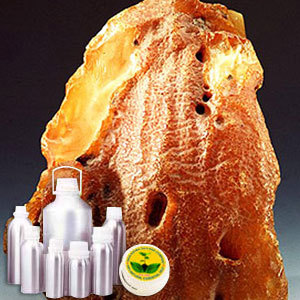Botonical Name | : | Pinus succinefera fossil | |
CAS # | : | 8002-67-3 | |
Country of Origin | : | India | |
Color & Odor | : | yellow-orange-brown with a typical resinous odor of coniferous forest | |
Solubility | : | Insoluble in water, soluble in alcohol and oils | |
Specific Gravity | : | 0.926 to 0.930 @ 20°C | |
Optical Rotation | : | +22° to +26° | |
Refractive Index | : | 1.465 to 1.480 @ 20°C | |
Flash Point | : | >100°C | |
Major Constituents | : | Calmative, antispasmodic, analgesic, Communic acid, Labdane | |
Extraction Method | : | Steam Distillation |
DESCRIPTION:
Known for its high therapeutic value, Amber Oil has rejuvenating effect on the mind and body. It promotes the flow of kundalini energy and electrical flow in human body. Amber is basically a type of tree resin from which this oil is extracted. This specific class of resin has close link with Jatoba class of wood which is known for its aphrodisiac properties. Jatoba is used to formulate energy boosting and stimulating tonic in Brazil. CONSTITUENTS:
Amber Essential Oil is known for its fever reducing properties, sedative attribute and is used to formulate drugs for treating cough. Rich in labdane and communic acid, this oil is used to heal spasm and pain. AROMATIC SUMMARY / NOTE / STRENGTH OF AROMA:
This oil has distinctive herbal and amber smell. BLENDS WITH:
The offered amber oil is soluble in different sorts of essential oils that include benzoin, cypress, cistus, galbanum, clove, myrrh, spruce, geranium, rose absolute, aniseed, cedar wood, pine, orange, lemon and frankincense. COMMON NAMES:
This oil is also referred as amber essential oil and amber refined oil. USES:
Amber oil is also used as indispensable part of formulating lotions, soap, air fresheners, diffusers, perfumes, aromatherapy items, massage oils, towel scent, bath oil, perfume based oil, body fragrance, detergents, incense and hair care products. It is also used in facial steams. 


































